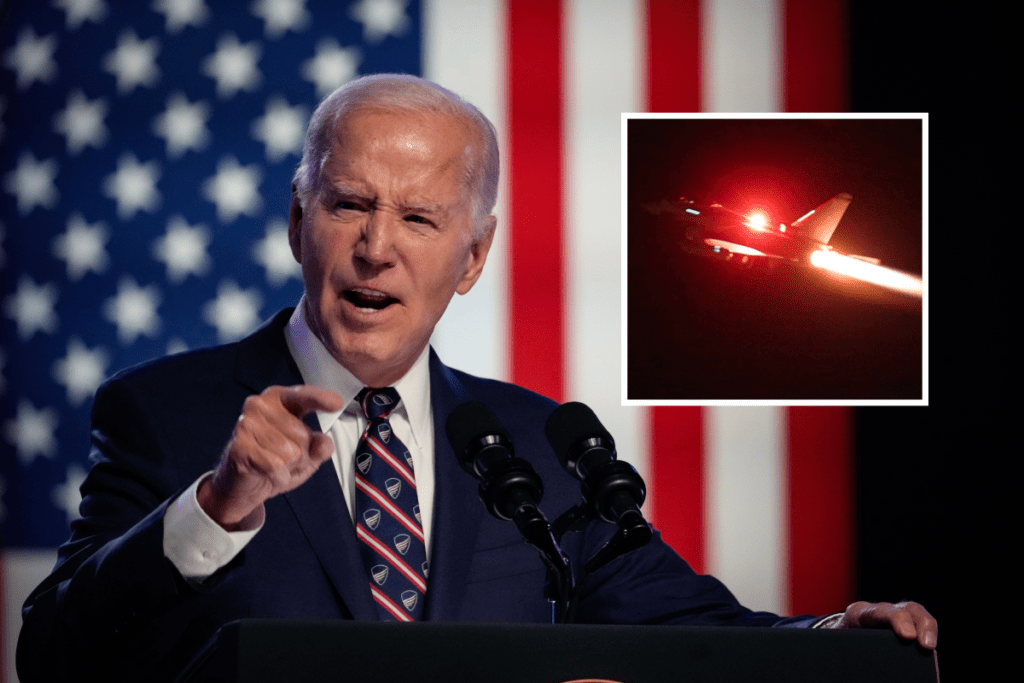us uk attack yemen
A U.S. Navy destroyer fired missiles at a Houthi radar site in Yemen early Saturday, a second-day attack against militants that followed American and British airstrikes late Thursday.
Saturday’s airstrike was against a radar installation that militants used to locate and attack commercial ships in the Red Sea, defense officials said. Its location was not disclosed.
Thursday’s attack was widespread, hitting more than 60 military targets in at least 28 locations in retaliation for monthslong Houthi strikes on commercial vessels.
The two strikes are a significant escalation of U.S. involvement in Middle East fighting since the Israel-Hamas war began Oct. 7. Strikes came from air and naval forces and focused on positions connected with Houthi military activity.
The Houthis, a militia group based in Yemen and backed by Iran, began attacking commercial shipping in the Red Sea shortly after Hamas invaded Israel. Houthi leaders said the attacks were in support of Hamas.
They said ships bound for Israel were being targeted, but few of the ships they attacked had direct links to Israel, ABC News reported.
The militants have used drones and missiles to attack 27 ships in international shipping lanes since Oct. 17, according to U.S. Central Command.
What did airstrikes target?
Saturday’s attack was reported late Friday. Yemen is eight hours ahead of U.S. Eastern time.
“These strikes are in direct response to unprecedented Houthi attacks against international maritime vessels in the Red Sea − including the use of anti-ship ballistic missiles for the first time in history,” President Joe Biden said in a statement late Thursday.
The U.S. Navy destroyer USS Carney launched Tomahawk missiles against the radar site Saturday, officials said. The strike was described as a follow-on to the attacks launched Thursday.
Satellite image ©2024 Maxar Technologies
Those attacks were the first by the U.S. military since the Houthis began firing upon ships in the Red Sea. Naval forces fired missiles on targets described as radar systems, drone sites and missile storage and launch locations. One hundred and fifty bombs and missiles were used, Army Lt. Gen. Douglas Sims, director of Joint Staff, said Friday.
The Houthis fired one anti-ship missile, which did not hit any ships, Sims said.
The strikes came from the air, surface and subsurface, the U.S. Naval Institute reported, including fighter jets from a base in the Middle East and from the aircraft carrier USS Dwight D. Eisenhower. Tomahawk missiles were launched from surface ships and at least one submarine, the institute said.
Houthi senior official Hussein al-Ezzi said the U.S. and U.K. “will pay a heavy price” for what the Houthis called blatant aggression. Leaders said five people were killed and six were wounded.
The Red Sea is a vital trade route between Asia and Europe, carrying an estimated 10% of world trade volume. Biden said more than 2,000 ships have been forced to travel thousands of miles to avoid the Red Sea, causing weeks of delay in shipping.
Iran increased political tension in the Middle East when its navy seized an oil tanker in the Gulf of Oman on Thursday, before the allied airstrikes were launched.
Though the oil tanker was not connected to the Houthi attacks, its confiscation threatened to spread hostilities eastward to the Persian Gulf, another key shipping route.
Why did US, allies attack Houthis?
U.S. officials said Thursday’s attack was in response to a series of drone and missile attacks against commercial vessels – and later, allied warships – in the Red Sea.
Oct. 7: Hamas invades Israel in a surprise attack, killing more than 1,200 people, most of them civilians. About 250 hostages are taken.
Oct. 17: Houthis begin attacking commercial ships in the Red Sea. The militants say the attacks, which are in support of Hamas and Palestinians, target vessels traveling to Israel, but their targets increasingly have little or no connection to Israel and lie in the thick of major commercial trade routes linking Asia and the Middle East with Europe.
Nov. 19: Houthis seize a cargo ship, British-owned and Japanese-operated, in the Red Sea. They say all ships linked to Israel are “legitimate targets.”
Dec. 3: Houthis strike three commercial ships with missiles in the Red Sea.
Dec. 12: Houthis hit Norwegian tanker MK Strinda with at least one missile, causing a fire. No casualties are reported.
Dec. 15: Houthis strike the cargo ships MSC Palatium III and Al Jasrah with two missiles in two separate attacks in the Red Sea.
Dec. 16: U.S. Navy destroyer USS Carney shoots down 14 drones launched by Houthis.
Dec. 18: U.S. and allies launch Operation Prosperity Guardian, a multinational coalition to defend shipping in the Red Sea.
Dec. 24: U.S. Navy destroyer USS Laboon and others shoot down more than a dozen drones and missiles in the Red Sea.
Dec. 26: Houthis claim responsibility for a missile attack on a container ship in the Red Sea.
Dec. 28: U.S. Navy destroyer USS Mason shoots down a drone and ballistic missile fired by Houthis.
Dec. 31: U.S. Navy helicopters sink three Houthi boats while repelling an attack on a Maersk container ship in the Red Sea. Ten militants are killed.
Jan. 6: The USS Laboon shoots down a drone fired by Houthis. Officials say the drone was fired upon “in self-defense.”
Jan. 9: U.S. and U.K. navy ships shoot down 21 Houthi drones and missiles that targeted allied warships. Officials say the Houthi attack was the largest in the Red Sea by militants to date. Defense Secretary Lloyd Austin, hospitalized for prostate cancer surgery, confers with Biden, who authorizes a retaliatory strike.
Jan. 11: Austin orders U.S. Central Command to attack. U.S. and allies strike at Houthi military sites in Yemen at 2:30 a.m. local time. The attack is made in two waves.

